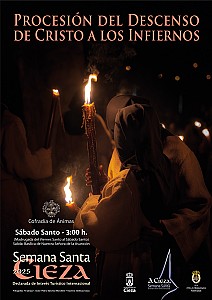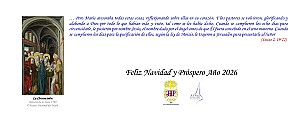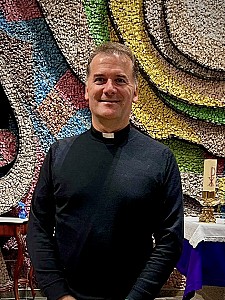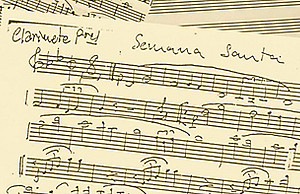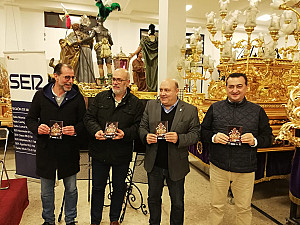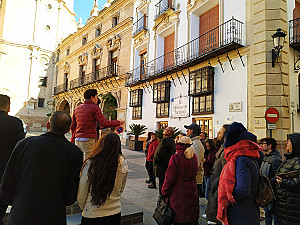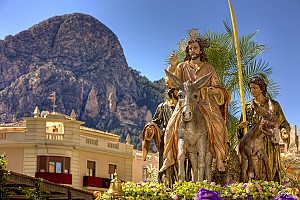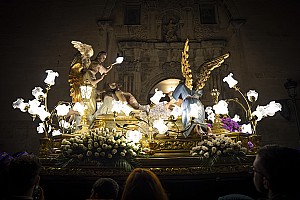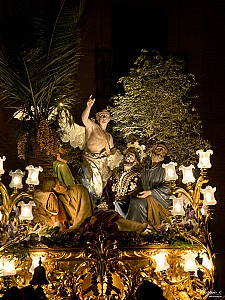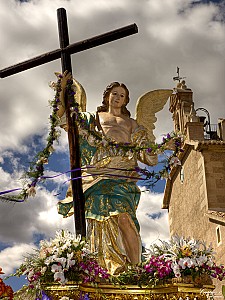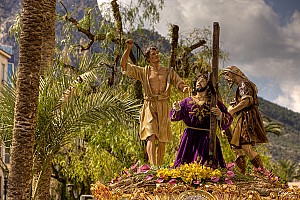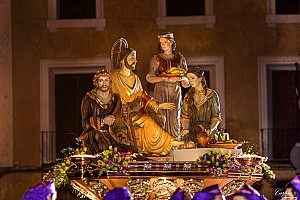Las primeras referencias del Paso El Santo Sepulcro lo remontan como muy tarde a mediados del siglo XVII, cuando la Cofradía de la Sangre de Cristo contaba por titular con un Crucificado con el que, desenclavado de la cruz y depositado en un catafalco, se celebraba por la tarde la ceremonia del Descendimiento y la posterior Procesión del Santo Entierro de Cristo. Así lo corrobora en 1682 el documento de cesión de unos terrenos que la Comunidad Franciscana que pretende instalarse en Cieza solicita para la edificación del que luego será Convento de Franciscanos Descalzos de San Joaquín y Custodia de San Pascual, y según el cual, en contrapartida, la cercana Ermita de San Sebastián, en la que se custodiaba El Santo Sepulcro, se convertiría en un Hospicio que habrían de regentar los propios frailes. En el acuerdo que se suscribe entre ambas partes se hace constar que "debe hacerse en el convento una capilla para colocar el Santo Sepulcro el Viernes Santo, y así pueda hacerse la Procesión del Santo Entierro de Jesucristo y se pueda entregar el Santo Crucifijo que hay en la Ermita de San Sebastián llevado en Procesión desde la Iglesia de la Asunción".
No se sabe desde cuándo contó el Paso con una Imagen propia, pero lo cierto es que los primeros testimonios sobre una Imagen de Cristo Yacente datan del siglo XIX y que esta, de autoría desconocida, fue destruida en la Guerra Civil.
La Imagen procesionaba bajo palio en el interior de una urna (coservada todavía hoy, aunque en condiciones muy precarias) que asemejaba la forma de una cama con dosel, lo que motivó que el Paso fuera conocido con el sobrenombre de 'La Cama de Cristo', como popularmente se le sigue llamando hoy día.
Desde la segunda mitad del siglo XIX estuvo vinculado, como está atestiguada su Camarería, a la familia Capdevila, desfilando en el seno de la Cofradía de Jesús -Nazareno-, que es la que sufraga los gastos derivados del mantenimiento del mismo, según diversos apuntes que constan en el Libro de cuentas de dicha Cofradía: "A Don Gaspar Victoria por el damasco y lienzo para el palio... 257 reales con 8; por balor de la percalina, costuras y tres baras de seda para dicho palio, traida de Murcia... 184 reales" (1851); "Por madera dorada para la Urna del Cristo del Sepulcro... 80 reales" (1865); y la que en 1873 solicita que la imagen del Señor del Sepulcro se ubique en la capilla de Soledad (en el mismo lugar que hoy se conserva la realizada en 1943 para sustituir a aquella). No obstante, a principios del siglo XX pudo haber procesionado al amparo de la Cofradía del Santísimo Sacramento, como parece desprende de un escapulario conservado en el que reza: "Cofradía del Santísimo Sacramento y Santo Entierro". Durante algunos años, después de acabar la Guerra Civil, figuró como Paso independiente, entrando a formar parte de la Cofradía de La Oración del Huerto, de la que sería su segunto titular.
Por su parte, el Paso de La Oración del Huerto, conocido también simplemente como 'El Paso', estuvo vinculado desde su realización a la familia de Moncada Aguado, que se asienta en Cieza en la segunda mitad del siglo XVIII, pudiendo haber sido esculpido por un autor desconocido en las primeras décadas del siglo XIX para desfilar bajo los auspicios de la Cofradía de Jesús -Nazareno-, que corre con los gastos derivados del mantenimiento del mismo como queda reflejado en la prensa local de finales de siglo (La Voz de Cieza, Crónica de la Semana Santa de 1899: "De novedades sólo ha figurado, sin terminar y por consiguiente sin el debido lucimiento, la tarima de La Oración del Huerto que ha sido construida aquí bajo la dirección del activo e incansable D. Antonio Aguado Moxó; la obra ha salido aparejada en blanco y sin terminar su decoración; por lo tanto cuando lucirá será el año que viene, terminada y dorada") y en el Libro de Cuentas de la Cofradía ("A Pascual Molina por arreglar la barca del paso de La Oración y tres estantes nuevos... 50 reales, a Manuel Villa por su asignación por la cobranza del Paso de La Oración... 200 reales" -1859-; "Al escultor D. Pedro Franco por restaurar a Jesús en La Oración... 640 reales, a Mariano Miranda por la conducción del paso a Murcia y a ésta... 19 reales" -1862-; "por vestir y dorar los jarros del paso de La Oración según recibo del dorador... 400 reales" -1870-) y a la que pertenecen los anderos de este Paso ("Por tarjas cobradas a los anderos de La Oración..." -1862-). A mediados de ese siglo ostenta la Camarería del Paso, el propio Hermano Mayor de la Cofradía, D. Antonio Aguado y Marín, y sucesivamente sus hijos D. Antonio y Dña. Visitación Aguado y Moxó. A la muerte de esta en 1917 se hace cargo del Paso hasta 1933 su hermano D. Manuel y tras su fallecimiento la propiedad y el cargo de Camareros pasaron a D. Manuel Moxó Ruano y a su esposa, quienes lo conservaron hasta después de la Guerra Civil. Desde el 'cocherón de los Ejíos', propiedad de la familia, el Paso participaba en la tradicional 'Traída de los Santos' y cuando esta dejó de celebrarse siguió contando durante años con un popular Traslado en la tarde de Miércoles Santo.
En 1935 los Anderos de La Oración del Huerto, hombres de avanzada edad al servicio de la familia Moxó, tras el Traslado del Miércoles Santo en el que el Paso estuvo a punto de venírseles abajo por su gran peso, rehúsan procesionarlo esa noche. A petición de los hermanos Yarza, un grupo de jóvenes que solían reunirse en la Barbería de 'Gige', en la Calle Cartas, encabezados por Bartolomé Herrera, cargó aquel año con 'los Dormijosos', como popularmente se conocía al Paso. Deciden constituirse en Cofradía, pero lamentablemente un año después estallaría la Guerra Civil. Reunidos nuevamente al término de esta, bajo la Presidencia primero de D. Pascual Moreno Balsalobre y después de D. Santiago García García inician los trámites precisos para que la Cofradía quede legalizada (en principio con la intención de que la Cofradía fuera filial de la de Jesús -Nazareno- y así "Cofradía de La Oración del Huerto, filial de la de Jesús"; pero definitivamente con carácter independiente como "Cofradía de La Oración del Huerto y El Santo Sepulcro"), lo que se consigue siendo Presidente de la misma D. Manuel Semitiel Aroca (1943-1949) y pasando a conocerse entre las gentes de Cieza, en el transcurso de los años, como 'los Dormis'.
En el mismo año de 1940, la Cofradía procesiona también con el Santo Sepulcro, titular de la Procesión del Santo Entierro, que no iba a tener lugar por haberse destruido la Imagen del Señor. Durante toda la tarde del Viernes Santo los Cofrades se dedican a la laboriosa tarea de armar el trono, en el que colocan un Cristo de escayola de medio cuerpo tapado con un valioso sudario propiedad de la Camarera del Paso, Dña. Mariquita Capdevila. Ella misma encarga dos años después al escultor local Manuel Juan Carrillo Marco un nueva Imagen para El Santo Sepulcro, que procesiona en 1943 y que se conserva actualmente en una urna de cristal en una de las capillas laterales de la Basílica de Nuestra Señora de la Asunción. En 1951, ante el lastimoso estado del trono, el escultor Manuel Juan Carrillo Marco, por encargo de la Cofradía, realiza el nuevo grupo escultórico del Santo Sepulcro y su correspondiente trono dorado y tallado en madera, aprovechando la Imagen de Jesús que esculpiera con anterioridad, al que se le van adosando hasta un total de cuatro ángeles custodios para quedar definitivamente acabado el año 1963, cuando Carrillo talla también una nueva escultura de Jesús para la Cofradía con el fin de sustituir a la que hasta entonces venía procesionando de propiedad particular. Las últimas intervenciones en el Paso se efectuaron en 1985, cuando el mismo Carrillo restauró las Imágenes, y en 1992, año en que Carmen Carrillo, hija del anterior, hizo lo propio. Desde su primera remodelación, el Paso no ha faltado a la cita con su Traslado de la tarde de Viernes Santo, el cual se realiza, como es tradicional, al son de los pasodobles de la Cofradía, hecho este que en alguna que otra época trajo consigo no pocos inconvenientes.
En 1949, bajo la presidencia de D. Antonio Torres Ortega, desfilan por primera vez nazarenos con el uniforme actual de la Cofradía, de color morado, y en 1954 se sustituyen las túnicas de percal negro de los anderos (color heredado de la Cofradía de Jesús) por las actuales moradas.
D. José Lucas Avellaneda (al frente de la Cofradía hasta el año 1959 tras un breve mandato de D. Antonio Alcaraz Ballesta durante el año de 1956) accede a la Presidencia en el año 1950 y ese mismo año se encarga un grupo escultórico de cinco Imágenes, La Entrada de Jesús en Jerusalén, popularmente conocido como 'La Burrica', para la Procesión de la Palma al imaginero Carrillo, quien también realiza un primer trono para el mismo. Dicho trono será sustituido a principios de los años sesenta por otro realizado en 1967 por el artista local Manuel Jaén que a su vez será destinado posteriormente a un nuevo Paso de la Cofradía. Durante unos años el grupo escultórico desfilará también sobre el antiguo tarimón del Paso de La Oración del Huerto, hasta que en 1988 Manuel Juan Carrillo realiza una nueva plataforma que fue terminada según el proyecto de trono original por su discípulo, el ciezano Bonifacio Pérez Ballesteros, el año 2003, habiéndose llevado a cabo la restauración de las Imágenes un año antes en los talleres murcianos de Javier Bernal Casanova.
En 1952 la Cofradía estrena su estandarte, bordado en oro y seda en el Convento de Carmelitas Descalzas de Lorca, así como dos faroles de Tercio y los báculos para los nazarenos, ambos realizados en los talleres ciezanos del Maestro Penalva. El Domingo de Resurrección de ese mismo año se bendice en la Basílica de Nuestra Señora de la Asunción la escultura tallada en madera del Ángel de la Cruz Triunfante, obra, al igual que el trono, de Manuel Juan Carrillo, con lo que la Cofradía se evita procesionar, como había hecho desde 1943, con el propio Ángel de La Oración del Huerto en la Procesión de Jesús Resucitado. La Imagen del Ángel de la Cruz Triunfante de Carrillo será sustituida en 1970 por otra de mayor tamaño que debemos a la gubia del escultor murciano José Sánchez Lozano y que procesionará sobre un nuevo trono del propio Carrillo (la talla original de Carrillo será recuperada en 1984 para el Desfile del Tercio infantil de la Cofradía).
En 1966, con D. José Salmerón Salmerón al frente de la Cofradía, se entra en contacto con la familia Moxó para obtener la propiedad del Paso titular, adquiriéndose el trono y las tres Imágenes de los Apóstoles, desapareciendo de Cieza el Ángel y conservando la familia la escultura del Señor. Un año después, Sánchez Lozano talla sendas esculturas del Cristo y del Ángel, fieles réplicas de las de Salzillo, reformando a su vez el grupo de los Apóstoles. Siendo finalmente en 1972, bajo la presidencia de D. Antonio Galindo Tormo (1969-1978) cuando se realice en Murcia un nuevo trono para el Paso titular tallado en madera y dorado por los Hermanos Lorente.
En 1973 desfila por primera vez La Caída, obra de José Sánchez Lozano, aunque sólo con las Imágenes de Jesús y el Cireneo, incorporándosele el Sayón al año siguiente, y lo hace sobre el trono que Manuel Jaén construyera para 'La Burrica'. Con la llegada de este nuevo Paso, el titular, que venía desfilando en la Procesión General del Miércoles Santo en la noche y en la Procesión del Penitente Viernes Santo en la mañana, dejará de hacerlo en esta segunda para incorporarse a la Procesión del Prendimiento en la noche de Martes Santo. El grupo escultórico fue restaurado en 2006 por Javier Bernal Casanova y el trono fue remozado, enriquecido y dorado por el tronista ciezano Bonifacio Pérez Ballesteros, que lo finalizó para la Semana Santa de 2007.
Tras el corto mandato de D. Antonio Gómez Salmerón durante el año 1979, comienza su andadura como Presidente D. Diego Ortega Rojas (1980-1999), quien encarga una nueva túnica de terciopelo morado para las Imágenes de Cristo de La Oración del Huerto y de La Caída, y con el que la Cofradía construirá en el año 1991 su propia Casa-Museo en los aledaños de la Basílica de Nuestra Señora de la Asunción.
En 1988 la Cofradía adquiere su sexto Paso, La Unción de Jesús en Betania, obra de Carmen Carrillo, integrado por las Imágenes de Lázaro y María, que desfila provisionalmente sobre una plataforma obra de Carrillo montada a su vez sobre la de 'La Burrica'. Remozadas estas un año después, en 1997 la propia escultora tallará las Imágenes de Lázaro y Marta que completan el Paso, que desde ese año procesionará sobre un nuevo trono realizado en cobre y plata por el orfebre ciezano Diego Penalva. El Paso, que hasta entonces participaba en la Procesión del Prendimiento en lugar de La Oración del Huerto, pasó a integrarse en la Procesión General, con lo que el titular quedó definitivamente ubicado en la primera.
En el año 2000 y bajo la presidencia de D. José Penalva Salmerón, la Cofradía renueva el vestuario de andero, que recupera el tradicional gorro de 'moco' y el cíngulo, en sustitución, respectivamente, del gorro de 'plato' y del fajín, introduciendo por primera vez para estos la túnica de terciopelo o lujo, en lugar de las habituales de tergal. Ya en el año 2008, la Cofradía estrena unos nuevos faroles de Tercio realizados totalmente en plata por el orfebre de Fuengirola, Cristóbal Angulo, siguiendo el diseño del Hermano de la Cofradía, Abelardo Salmerón, así como un nuevo varal para su estandarte, realizado también por el orfebre malagueño en consonancia con el diseño de los faroles. Por último, y bajo la presidencia de D. Antonio Gómez Ruiz, se encargan unos nuevas galas para los Pasos de la Cofradía, diseñadas y bordadas en los talleres sevillanos de Jesús Gómez.
Fotografías de Manuel Carpio y Enrique Centeno.
© Junta de Hermandades Pasionarias de Cieza
